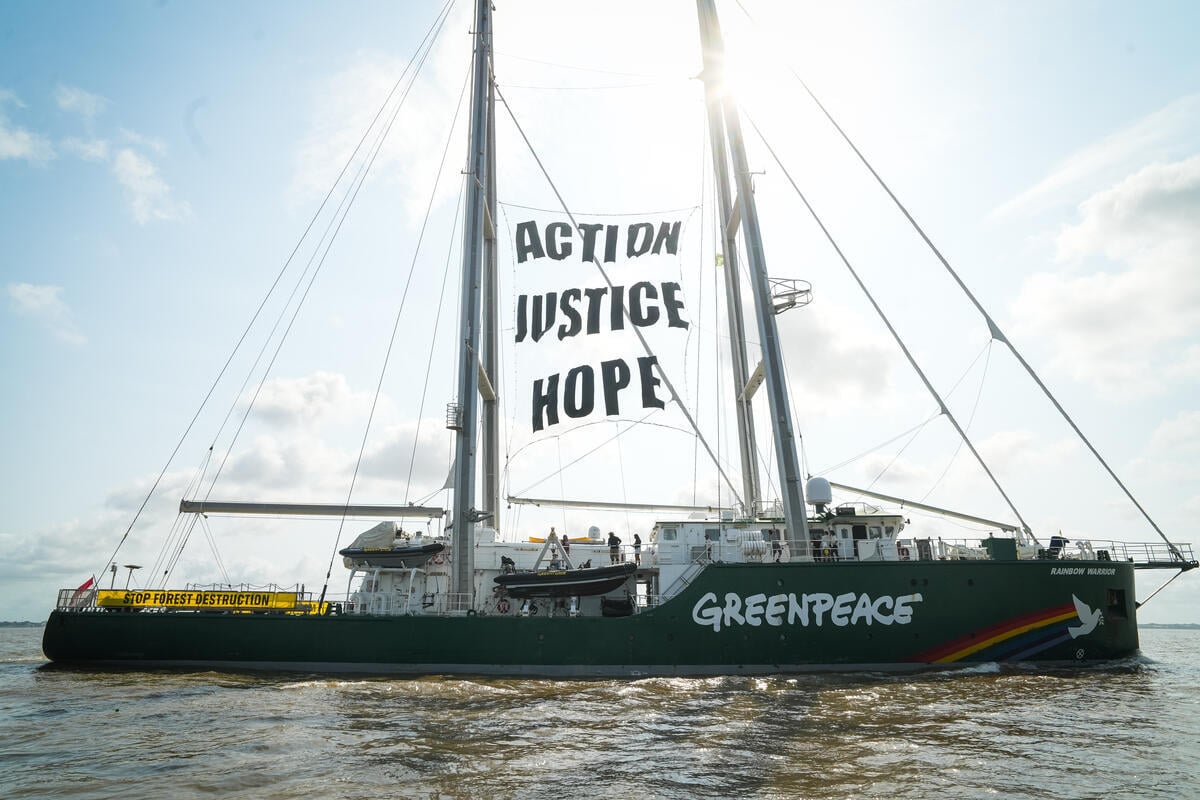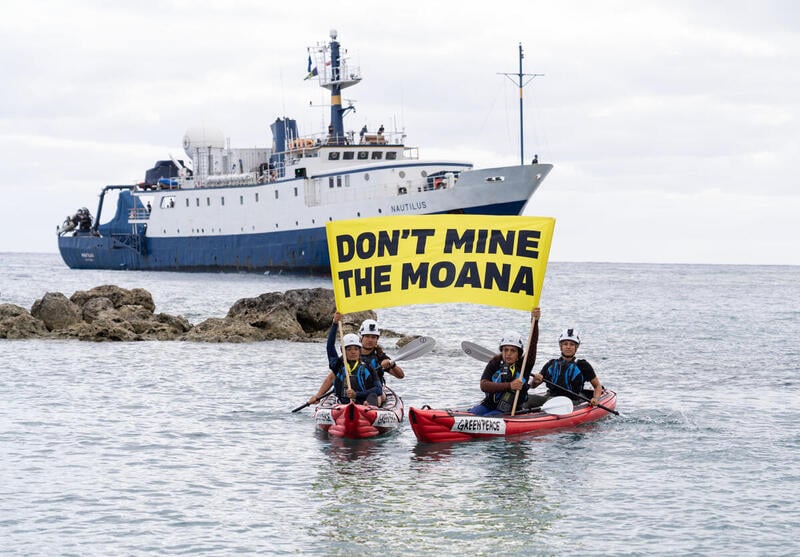This is a story of how a few pioneers went to one of the most remote regions on Earth and got a seat at the table of Antarctic Treaty Nations, and then proceeded to convince global leaders to believe in the dream of having Antarctica protected as a world park. It was ambitious and it took time, but they showed that with persistence, big things are possible.
Now, we’re aiming to convince world leaders to protect the waters surrounding World Park Antarctica. It’s also ambitious, but together we can do it. We’ve done it before.
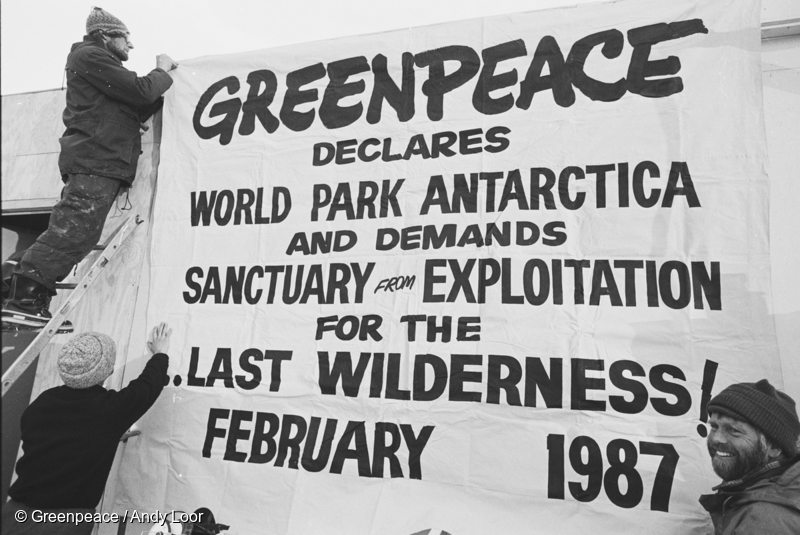
World Park Antarctica banner reading:
“Greenpeace declares World Park Antarctica and demands Sanctuary from Exploitation for the last wilderness February 1987”.
Antarctica: The Final Frontier
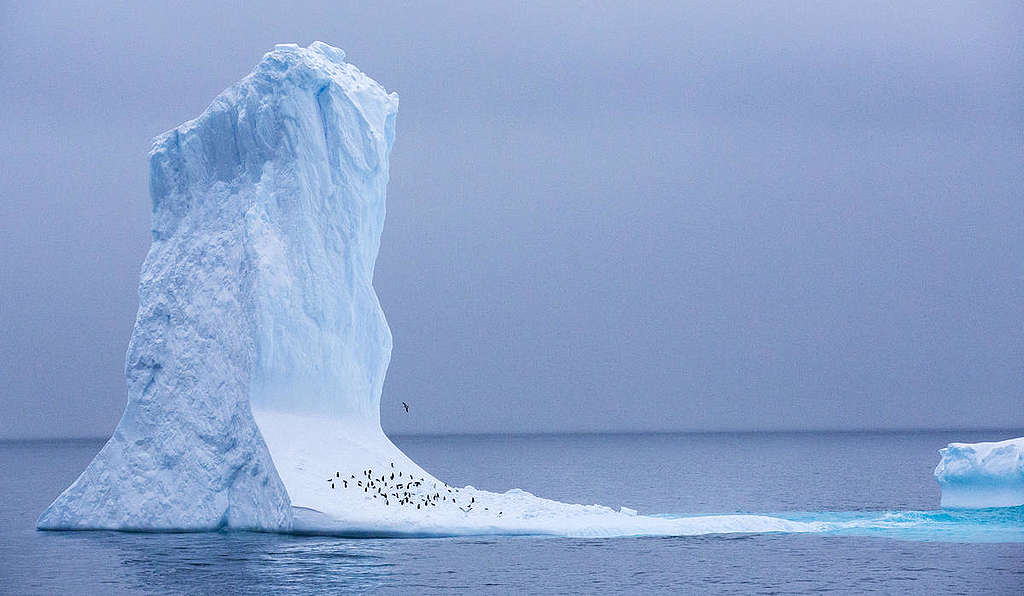
Penguins take shelter on an Iceberg, close to Trinity Island, in the Antarctic. Greenpeace is documenting the Antarctic’s unique wildlife, to strengthen the proposal to create the largest protected area on the planet, an Antarctic Ocean Sanctuary.
Antarctica is the only continent that remains relatively untouched by human interference; it’s arguably the closest thing we have to a pristine wilderness left on Earth. Its role in protecting biodiversity is significant but scientists can also use this unique environment to gain insight into pollution and climate change in a way that cannot be achieved elsewhere.
Yet in the early 1980s, commercial exploitation threatened this delicate ecosystem. There is strong evidence for the existence of oil and mineral deposits under the ice, meaning governments and companies were lining up to start prospecting. This is frightening because the Antarctic is particularly susceptible to oil spills and other types of pollution. A single spill could devastate the area.
Greenpeace World Park Base
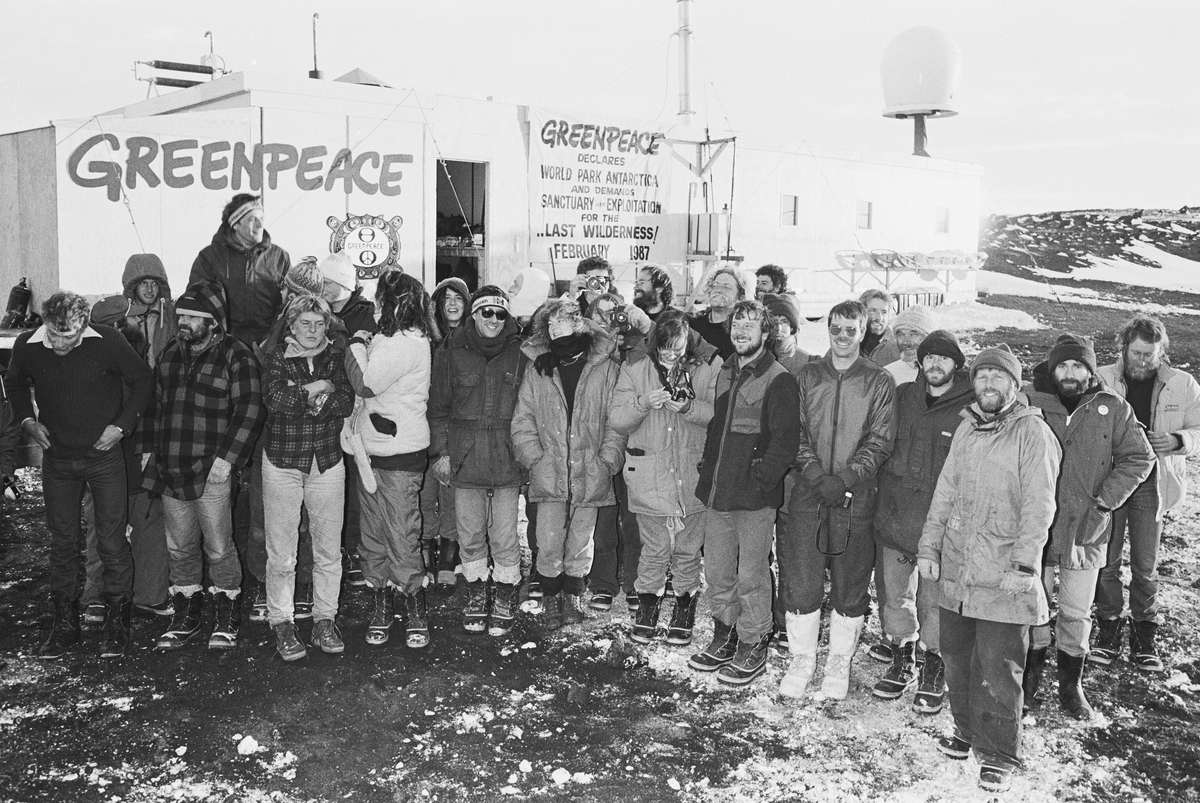
World Park Antarctica. Group shot.
The idea for a campaign to make Antarctica a ‘World Park’ was first suggested by Greenpeace in 1979. However, rules dictated that we would have to set up a permanent base on the ice if we were to have a voice at the Antarctic Treaty table. Only a base would allow us to challenge national territorial claims with an argument that Antarctica should be preserved as a global common—belonging to no one.
No non-governmental organisation had ever set up a base in Antarctica; there were many obstacles, both political and practical. In 1987 the MV Greenpeace moored in the Antarctic (after weather had halted their first attempt) and a few weeks later the World Park Base was operational. The intrepid Greenpeace pioneers stayed from 1987 to 1991.
The Antarctic Treaty Nations, plus One NGO
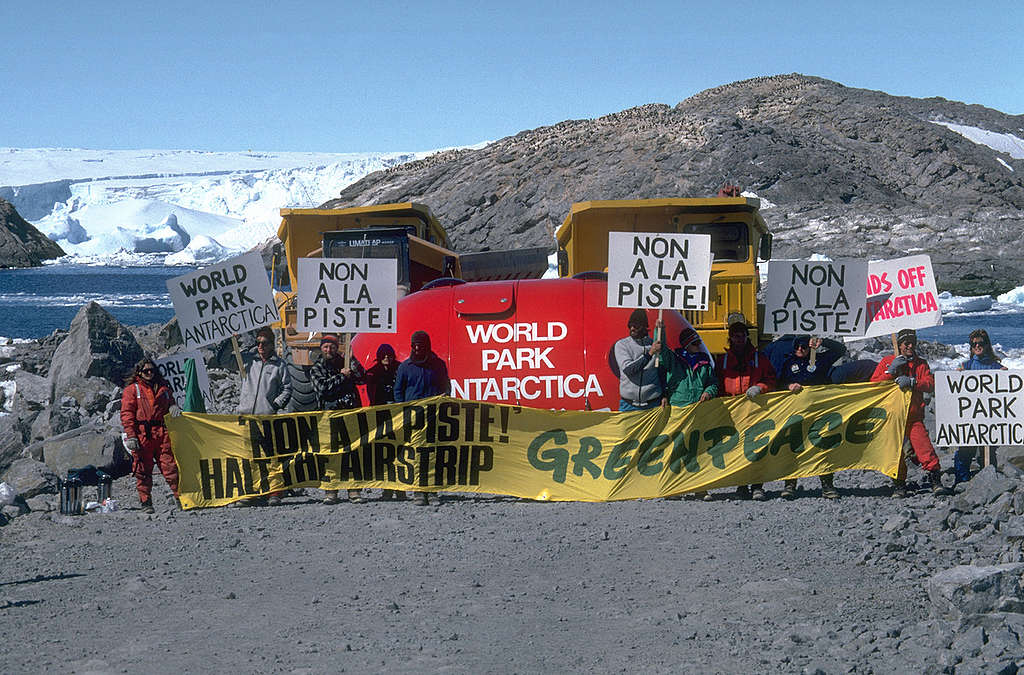
Greenpeace blockade of airstrip site at French base Dumont D’Urville, Antarctica.
The team monitored pollution from neighbouring bases and held other nations accountable for their actions. Greenpeace made headlines when 15 protesters blocked the French from building an airstrip at Dumont d’Urville. The construction work was controversial because it involved dynamiting the habitat of nesting penguins. French scientists even admitted an airstrip violated terms of the Antarctic Treaty.
During the protest French construction workers reacted angrily to a Greenpeace demonstration; workers forcibly evicted the protesters and smashed up a hut we had erected. Despite continuing threats of violence, the protesters returned to occupy the landing strip for a second day. The French later abandoned plans to build the airstrip.
Over time, our persistence and the professionalism of our operation gradually earned respect from other Antarctic Treaty Nations. After seven years of campaigning, Greenpeace went from being perceived as a crazy outsider in Antarctic Treaty affairs to becoming a respected player in negotiations for the future of the continent.
Antarctic Treaty Nations Adopt an Environmental Protocol
In 1989, the Exxon Valdez oil spill in Alaska undermined any oil company’s argument that drilling in ecologically sensitive areas could be conducted in a safe, environmentally friendly manner. Greenpeace offices worldwide lobbied their governments to take a responsible position protecting the Antarctic, joining forces with other non-governmental organisations and eliciting support from personalities including Prince Sadruddin Aga Khan, Jacques Cousteau, and Ted Turner.
Gradually more and more Treaty signatories were pers귭 of the merits of making Antarctica a World Park. In 1991, the members of the Antarctic Treaty agreed to adopt a new Environmental Protocol, including a 50-year minimum prohibition on all mineral exploitation.
This meant ensuring that knowledge to be gained from Antarctica’s unique environment could be maintained for years to come, a victory for people, penguins, and the environment. It showed that people power was able to overcome commercial interests, sending a message that Antarctica could not be mined for profit with a socially conscious public around to fight back.
Our continued work in Antarctica
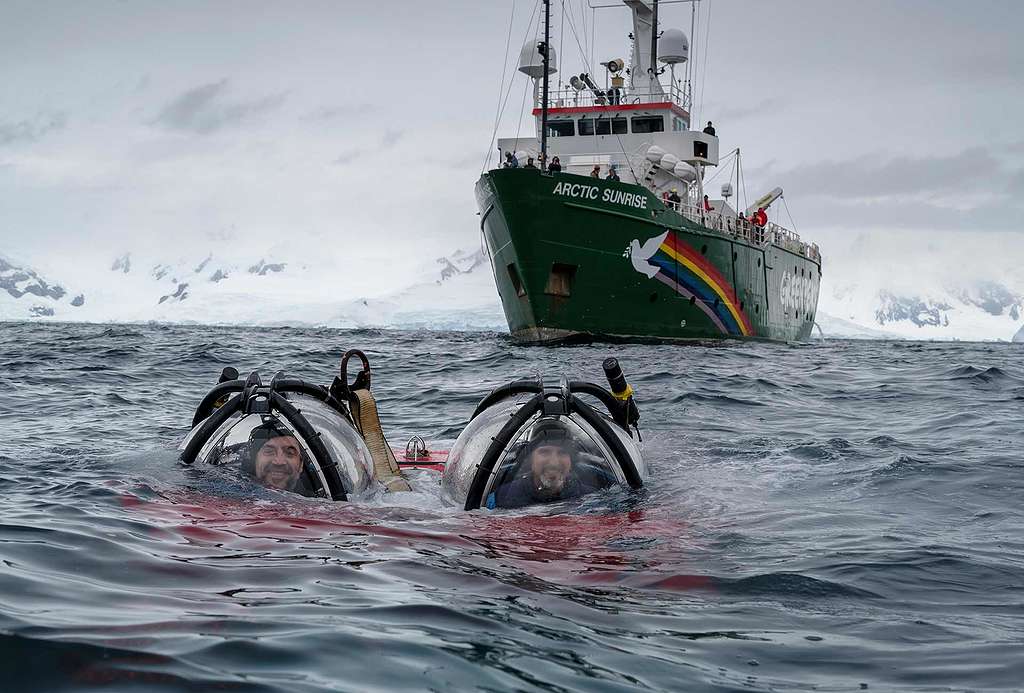
Actor and Antarctic ambassador Javier Bardem and submarine pilot John Hocevar from Greenpeace USA surfacing after exploring the Antarctic seafloor on around 270 meters depth in Charlotte Bay off the Gerlache Strait.
This people power nearly prevailed again recently. In January we launched an ambitious campaign to create the world largest ocean sanctuary in the Weddell Sea. The aim being to stop commercial fisheries exploiting Antarctica’s natural riches and devastating the entire ecosystem. In less than a year this campaign gathered roughly 2.7 Million supporters around the world.
The Antarctic Ocean Commission (CCMLAR) met in Hobart, Australia in October this year to discuss the proposed sanctuary. For the sanctuary to be approved there needed to be a unanimous vote by all governing bodies taking part. Unfortunately, it was blocked after a fortnight of meetings behind closed doors. Of the 25 governing bodies debating, only Russia, China and Norway chose not to support it. We were agonisingly close to a truly historic breakthrough but shows the success the campaign has received in its early days.
Although it’s very frustrating to see the sanctuary blocked, what’s encouraging is it was only blocked by 3 nations. Soon the UN will be discussing similar treaty’s that could potentially see large areas of oceans protected so it’s important to maintain this momentum or even increase it. Like any breakthrough act in history the first could lead to many more.
It’s a Marathon not a Sprint
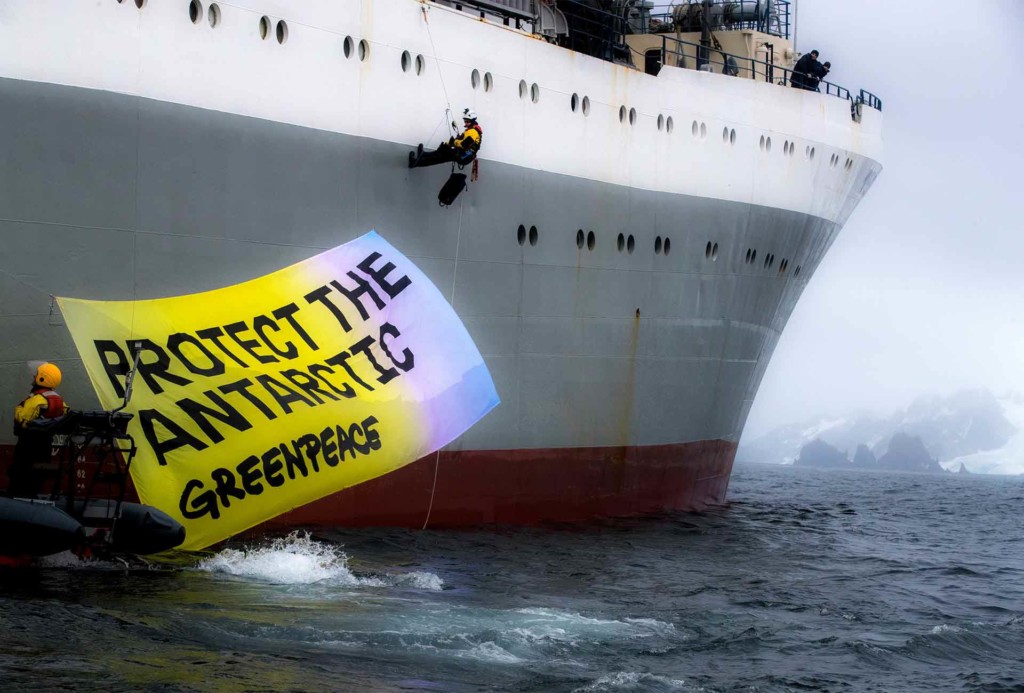
Greenpeace activists in peaceful protest, displaying a banner saying “Protect the Antarctic” on the Ukrainian krill trawler ‘More Sodruzhestva’ in the Bransfield Strait near Greenwich Island, Antarctic. Greenpeace is calling for the krill industry to commit to stop fishing in any area being considered by governments for ocean sanctuary status, and to back proposals for marine protection in the Antarctic.
Despite the Disappointment of the Antarctic Ocean Commission blocking the proposed sanctuary it’s important that we continue to pursue what will be a historic achievement, things like this take time. Earlier this year we managed to end any oil and gas exploration on our coastlines. Last week that was officially put into legislation. It was hugely rewarding for everyone involved and a lot of people don’t realise we worked for 8 years to get this in place.
Several historic environmental breakthroughs did not come overnight. Teddy Roosevelt was an early champion of conservation. He was responsible for so many protected areas of land in the early 20th century as part of the U.S national park system. It was not until 1972 when marine life received the same treatment. The Marine Research and Sanctuary Act was the first-time areas rich with marine biodiversity was protected.
When Rachel Carson released Silent Spring in 1962, it had a monumental impact on the modern environmental movement. The publication really captured the popular imagination by simplifying complicated scientific issues concerning widespread pesticide usage in US agriculture. The book was so popular it was translated from English into 12 different languages and remained in the New York Times best seller list for an impressive thirty-one weeks (Guha, 2000).
The success of Silent Spring manifests in the rise of the new environmental movement in the 1960s. The first earth day on the 22nd April 1970 is evidence of this, 20 million people took part in the demonstrations across the US making them the largest in history (Kirk, 2007). Environmental activists for the first time were not rich white men concerned with saving the environment for their personal enjoyment. Activists became your typical long haired, school drop-out, draft dodging ‘hippies’, concerned with preserving the future of humanity because of pesticide usage and the growing threat of nuclear fallout. Evident in the Don’t Make a Wave Committees’ first trip to Amchitka to protest U.S. underground nuclear testing in 1971. This protest was responsible for the eventual formation of Greenpeace (Zelko, 2013).
The widespread popularity for the new environmental movement became inescapable in popular culture too. Even some of the most popular bands of the decade began making albums that were entangled with environmental concerns like The Beach Boys 1971 album, Surfs Up. Even Joni Mitchel’s hit Big Yellow Taxi calls for farmers to drop pesticide usage.
Despite Silent Spring’s instant global popularity and really kick starting the modern Environmental movement, it took 10 years until strict pesticide regulation was put in place. In 1972 the Federal Environmental Pesticide Control act was passed. This act ensured the regulation of pesticide usage and policing of pesticide trade. It also classified the different types of pesticides and the penalties for illegal usage (Stoll, 2007).
With this in mind. The fact that we got 22 governing bodies to support what would be the largest protected area on earth in less than a year, just shows the success of the campaign so far. This should encourage us all to keep working on this, and use our people power, because it’s impossible to imagine it not being made any time soon if we keep up this fight.

